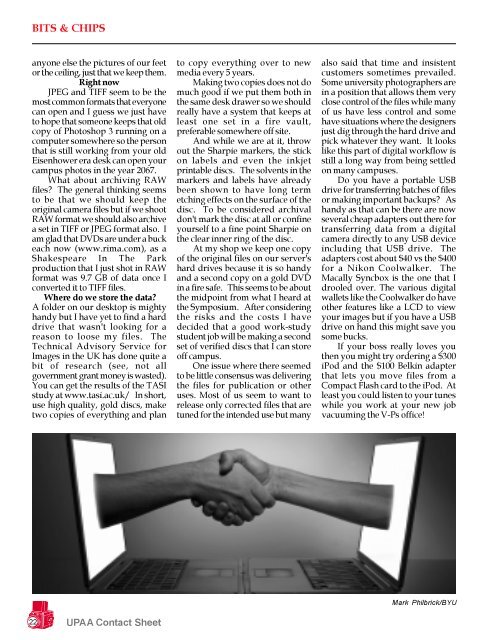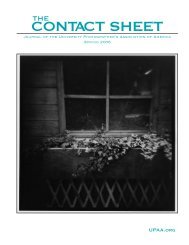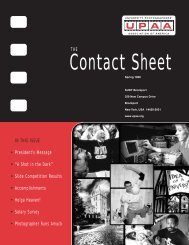Winter 2005 - University Photographers' Association of America
Winter 2005 - University Photographers' Association of America
Winter 2005 - University Photographers' Association of America
You also want an ePaper? Increase the reach of your titles
YUMPU automatically turns print PDFs into web optimized ePapers that Google loves.
BITS & CHIPS<br />
anyone else the pictures <strong>of</strong> our feet<br />
or the ceiling, just that we keep them.<br />
Right now<br />
JPEG and TIFF seem to be the<br />
most common formats that everyone<br />
can open and I guess we just have<br />
to hope that someone keeps that old<br />
copy <strong>of</strong> Photoshop 3 running on a<br />
computer somewhere so the person<br />
that is still working from your old<br />
Eisenhower era desk can open your<br />
campus photos in the year 2067.<br />
What about archiving RAW<br />
files? The general thinking seems<br />
to be that we should keep the<br />
original camera files but if we shoot<br />
RAW format we should also archive<br />
a set in TIFF or JPEG format also. I<br />
am glad that DVDs are under a buck<br />
each now (www.rima.com), as a<br />
Shakespeare In The Park<br />
production that I just shot in RAW<br />
format was 9.7 GB <strong>of</strong> data once I<br />
converted it to TIFF files.<br />
Where do we store the data?<br />
A folder on our desktop is mighty<br />
handy but I have yet to find a hard<br />
drive that wasn't looking for a<br />
reason to loose my files. The<br />
Technical Advisory Service for<br />
Images in the UK has done quite a<br />
bit <strong>of</strong> research (see, not all<br />
government grant money is wasted).<br />
You can get the results <strong>of</strong> the TASI<br />
study at www.tasi.ac.uk/ In short,<br />
use high quality, gold discs, make<br />
two copies <strong>of</strong> everything and plan<br />
to copy everything over to new<br />
media every 5 years.<br />
Making two copies does not do<br />
much good if we put them both in<br />
the same desk drawer so we should<br />
really have a system that keeps at<br />
least one set in a fire vault,<br />
preferable somewhere <strong>of</strong>f site.<br />
And while we are at it, throw<br />
out the Sharpie markers, the stick<br />
on labels and even the inkjet<br />
printable discs. The solvents in the<br />
markers and labels have already<br />
been shown to have long term<br />
etching effects on the surface <strong>of</strong> the<br />
disc. To be considered archival<br />
don't mark the disc at all or confine<br />
yourself to a fine point Sharpie on<br />
the clear inner ring <strong>of</strong> the disc.<br />
At my shop we keep one copy<br />
<strong>of</strong> the original files on our server's<br />
hard drives because it is so handy<br />
and a second copy on a gold DVD<br />
in a fire safe. This seems to be about<br />
the midpoint from what I heard at<br />
the Symposium. After considering<br />
the risks and the costs I have<br />
decided that a good work-study<br />
student job will be making a second<br />
set <strong>of</strong> verified discs that I can store<br />
<strong>of</strong>f campus.<br />
One issue where there seemed<br />
to be little consensus was delivering<br />
the files for publication or other<br />
uses. Most <strong>of</strong> us seem to want to<br />
release only corrected files that are<br />
tuned for the intended use but many<br />
also said that time and insistent<br />
customers sometimes prevailed.<br />
Some university photographers are<br />
in a position that allows them very<br />
close control <strong>of</strong> the files while many<br />
<strong>of</strong> us have less control and some<br />
have situations where the designers<br />
just dig through the hard drive and<br />
pick whatever they want. It looks<br />
like this part <strong>of</strong> digital workflow is<br />
still a long way from being settled<br />
on many campuses.<br />
Do you have a portable USB<br />
drive for transferring batches <strong>of</strong> files<br />
or making important backups? As<br />
handy as that can be there are now<br />
several cheap adapters out there for<br />
transferring data from a digital<br />
camera directly to any USB device<br />
including that USB drive. The<br />
adapters cost about $40 vs the $400<br />
for a Nikon Coolwalker. The<br />
Macally Syncbox is the one that I<br />
drooled over. The various digital<br />
wallets like the Coolwalker do have<br />
other features like a LCD to view<br />
your images but if you have a USB<br />
drive on hand this might save you<br />
some bucks.<br />
If your boss really loves you<br />
then you might try ordering a $300<br />
iPod and the $100 Belkin adapter<br />
that lets you move files from a<br />
Compact Flash card to the iPod. At<br />
least you could listen to your tunes<br />
while you work at your new job<br />
vacuuming the V-Ps <strong>of</strong>fice!<br />
Mark Philbrick/BYU<br />
22<br />
UPAA Contact Sheet




